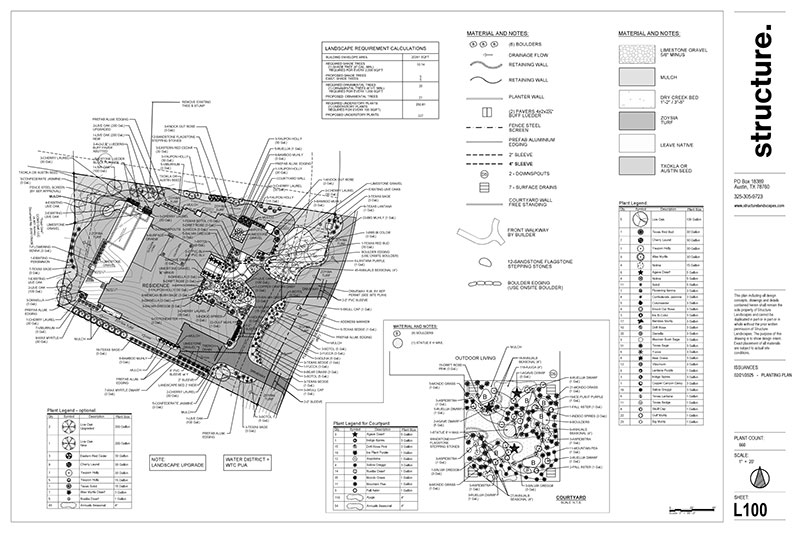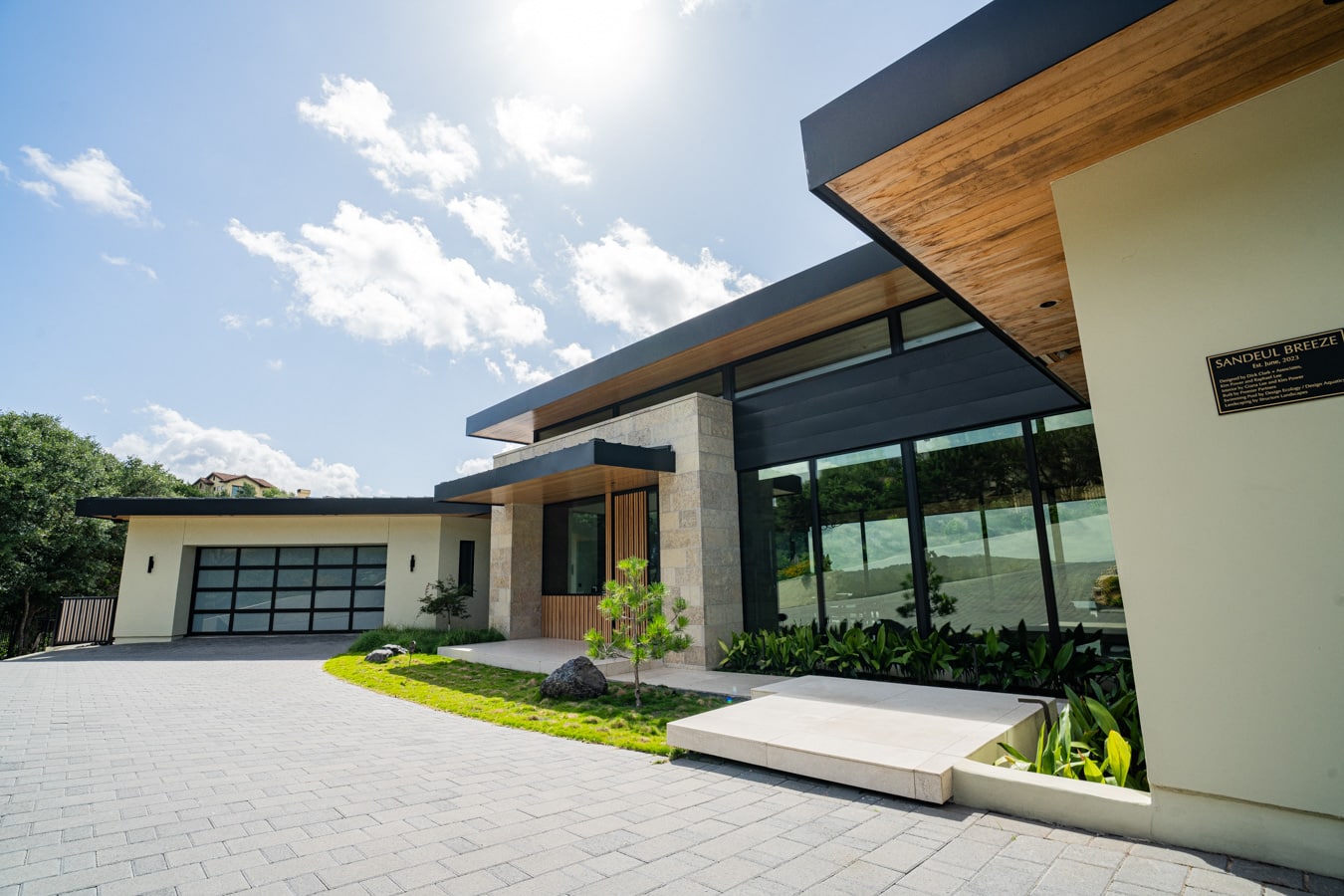Maintaining the beauty and functionality of your property is essential, whether residential or commercial. Landscape repair is a crucial aspect of property management that ensures your outdoor spaces remain inviting and well-kept. Neglecting these areas can lead to bigger issues down the line, from erosion to pest infestations.
You may wonder what landscape repair entails. At Structure Landscapes, our architects focus on restoring plant health, solving drainage issues, and revitalizing hardscape features. Implementing these repairs not only enhances curb appeal but also builds trust in the value of your property.
Taking proactive steps in landscape repair can save you time and money in the long run. You’ll create a welcoming environment for guests and increase the functionality of outdoor spaces.
Identifying Common Landscape Damages
To comprehend the current state of your landscape, start by observing any visible problems. Common issues include:
Dead Plants: Lack of water, disease, or poor soil can contribute to plant mortality. Check for discolored leaves, wilting, or stunted growth.
Thatch Buildup: Thatch is the layer of dead grass and organic material that accumulates on the soil surface. A thickness of over half an inch can impede water and nutrient absorption.
Compacted Soil: Heavy foot traffic or machinery can compact soil, limiting root growth and drainage.
Weed Growth: Unwanted weeds often indicate underlying issues like nutrient deficiencies or poor maintenance.
Identifying these signs early can prevent further damage and lead to a more effective repair plan.
Assessing Damage Extent
Once issues are identified, assess how widespread and severe the damage is. Use these methods to evaluate the situation:
Visual Inspection: Walk your landscape and note areas affected. Look for patterns, such as clusters of dead plants or extensive thatch.
Soil Test: Conduct a soil test to determine pH and nutrient levels. This will provide insights into whether soil conditions contribute to plant health.
Thatch Measurement: Use a garden knife to cut into the turf and measure thatch thickness. If it exceeds 0.5 inches, it may need removal.
Water Drainage Check: Observe how quickly water drains after rainfall. Poor drainage can signal compacted soil or improper grading.
Understanding the extent of damages enables you to prioritize repairs effectively, ensuring a healthier landscape.
Foundations of Landscape Repair
Understanding the basics of landscape repair involves several critical elements. Prioritizing soil health, drainage, and plant selection is essential for creating a sustainable environment. Each of these elements is crucial in effectively restoring and maintaining your landscape.
Soil Health and Preparation
Soil is the foundation of any landscape. Begin by assessing your soil’s composition and nutrient levels.
Key steps for improving soil health include:
Fertilizing: Use organic fertilizers to introduce essential nutrients.
Aerating: This process increases airflow to roots and helps microbial activity.
Mulch: Applying a layer of mulch conserves moisture and suppresses weeds.
Prepare the soil by tilling and incorporating compost or organic matter. This promotes better drainage and nutrient retention, creating a thriving environment for plants.
Importance of Proper Drainage
Effective drainage prevents water from pooling, which can harm your plants. Poor drainage can lead to root rot and other fungal diseases.
To enhance drainage, consider:
Grading: Ensure your landscape slopes away from structures.
French Drains: Install these to redirect excess water away from problem areas.
Soil Amendments: Incorporate elements like sand or perlite to improve drainage in heavy soils.
Regularly monitor your landscape after heavy rains. Adjustments may be necessary if you notice water pooling in specific areas.
Choosing the Right Plants
Selecting plants suited to your local climate and soil type is essential for successful landscape repair. Native plants typically require less water and maintenance. Research drought-resistant options that thrive in your area’s conditions.
Consider these factors when choosing plants:
Watering Needs: Opt for plants with similar watering requirements to streamline maintenance.
Sunlight Exposure: Know whether your area has full sun or shade to select appropriate species.
Soil Preference: Match plants to the amended soil type.
By carefully selecting the right plants and considering their compatibility with your landscape conditions, you can achieve a vibrant and sustainable garden.
Lawn Repair Strategies
Effective lawn repair requires a combination of techniques tailored to your specific needs. The following strategies focus on rebuilding grass density, eliminating weeds, and maintaining healthy soil.
Overseeding and Sod Installation
Overseeding helps thicken your lawn by adding new grass seed to existing turf without disturbing the soil. This method is ideal for areas experiencing thinning due to wear, pests, or environmental stress.
- Timing: Early spring or fall is best for overseeding.
- Preparation: Mow your lawn lower than usual and rake to remove debris.
- Seed Selection: Choose a seed mix that matches your existing grass type and climate.
Sod installation is an immediate fix for large bald spots. It provides instant coverage and a uniform appearance.
- Preparation: Ensure the soil is loosened and leveled.
- Installation: Lay sod in a staggered pattern to avoid seams.
- Watering: Keep the sod consistently moist for the first few weeks.
Weed Removal Techniques
Effective weed management is vital for successful lawn repair. Weeds can compete for nutrients, water, and light.
- Manual Removal: Pull out weeds by hand, ensuring you remove the entire root.
- Herbicides: Use selective herbicides that target specific weeds without damaging your grass.
- Preventive Measures: Regular mowing at the right height limits weed growth.
- Mulching: Apply mulch in garden beds to suppress weed growth and retain moisture.
Consistent weed control enhances the success of your lawn repair efforts.
Thatch Control Methods
Thatch is a layer of dead grass and roots that sits on the soil surface, which can prevent nutrients from reaching the roots.
- Aeration: Use a core aerator to remove plugs of soil. This process allows water, air, and nutrients to penetrate deeper.
- Dethatching Rake: A dethatching rake can manually remove thatch buildup. Rake aggressively in multiple directions for effectiveness.
- Proper Mowing: Regular mowing aids in controlling thatch. Keep your mower blades sharp and maintain an appropriate mowing height.
Garden and Plant Maintenance
Maintaining your garden is essential for healthy plant growth and landscape aesthetics. Focus on proper pruning techniques and seasonal care to keep your plants thriving.
Pruning and Trimming Best Practices
Pruning encourages healthy growth and can enhance the appearance of your plants. Begin by assessing the specific needs of each plant species. Use sharp, clean tools to make precise cuts.
Best Practices:
- Timing: Prune during the dormant season for most trees and shrubs.
- Technique: Cut just above a leaf node or branch junction to promote new growth.
- Health: Remove dead, damaged, or diseased branches first.
Proper trimming of trees and shrubs also shapes their size and improves air circulation. Avoid over-pruning, which can stress plants and slow growth.
Seasonal Plant Care
Your plants require different care throughout the year. Adjusting your maintenance routine can significantly impact their health.
Seasonal Tasks to Consider:
- Spring: Fertilize and mulch to encourage new growth. Check for pests.
- Summer: Water deeply and regularly. Monitor for signs of heat stress.
- Fall: Trim back perennials and prepare your garden for winter.
- Winter: Protect sensitive plants with mulch or covers.
By actively participating in each season’s care, you can enhance the vibrancy and longevity of your landscape. Regular attention ensures that your garden remains a flourishing environment.
Irrigation System Repair and Maintenance
Maintaining an efficient irrigation system is essential for healthy landscapes. This involves both regular upkeep of the sprinkler system and applying effective watering techniques for your plants.
Effective Watering Techniques
Optimizing your watering techniques can improve water efficiency and landscape health. Aim to water early in the morning or late in the evening to minimize evaporation. This ensures that more water reaches the roots of your plants.
Utilize a watering schedule tailored to the specific needs of your landscape. Group plants with similar watering requirements together. Employ mulch in garden beds to retain moisture and reduce the frequency of watering. Implement drip irrigation for water-sensitive areas, such as around flower beds or water fountains, to provide targeted hydration without waste.
Hardscaping Elements Restoration
Restoring hardscaping elements is essential for maintaining the aesthetic and structural integrity of your landscape. This process typically involves the repair and rejuvenation of pavers, stonework, retaining walls, and edging materials to ensure they look their best and function effectively.
Pavers and Stonework Repair
Pavers and stonework often suffer from wear due to weather and use. Cracks or uneven surfaces can detract from your landscape’s appearance.
You should begin by assessing the condition of the pavers. If they are loose, you may need to reset them. Clean the surface thoroughly to remove dirt and debris before applying a proper adhesive if necessary.
For cracks, use a specialized filler designed for stone materials. This helps prevent water infiltration, which can lead to further damage. Regular sealing can also protect your pavers from stains and moisture.
Retaining Walls and Edging Fixes
Retaining walls and edging are crucial for landscape design and soil erosion prevention. Over time, they can become unstable due to shifting soil or water damage.
Check for signs of bowing or cracking. If needed, reinforce the wall with additional materials. Replacing damaged stones or bricks enhances both durability and appearance.
For edging, ensure it’s well-defined and structurally sound. You can replace broken sections or add fresh materials like stone or concrete. Use a level to maintain a straight line, which will enhance the overall look of your landscape.
Hiring Professional Landscape Design Services
When considering landscape services, assess your specific needs—whether it’s lawn care, garden design, or maintenance.
Evaluate potential candidates based on their qualifications, services offered, and customer reviews.
Our landscape architects are committed to restoring and enhancing your landscape with high-quality services tailored to your needs.
Contact us today at (512) 461-0290 to discover how our landscape repair and revitalization services can rejuvenate your outdoor space.
Working with Tree Services
Tree services can be essential for maintaining the health and aesthetics of your landscape. When hiring a tree service, seek professionals who specialize in tree care and management. This includes pruning, removal, and disease management.
Ask about their experience with various tree species and their approach to safety. Look for certifications, which indicate a commitment to industry standards. It’s also important to obtain multiple estimates to find competitive pricing while ensuring quality service.
Ensure the company follows local ordinances regarding tree removal and care. A knowledgeable tree service can help enhance your landscape’s beauty while preventing potential hazards.
Strategies for Ongoing Maintenance
Maintaining a landscape requires consistent effort and care. Here are effective strategies to keep your residential landscaping in optimal condition.
1. Regular Lawn Care Services
Scheduling regular lawn care services will help ensure your turf remains healthy. Our architects can handle mowing, aeration, and fertilization effectively.
2. Implement a Watering Schedule
Establish a watering routine based on your local climate. Deep watering is preferred over frequent shallow watering. This encourages deeper root growth.
3. Fertilization
Use a balanced fertilizer to provide essential nutrients. Pay attention to the specific needs of your turf type.
4. Weed Control
Regularly inspect your landscape for weeds. Use mulch in garden beds and consider pre-emergent herbicides to prevent weed growth.
5. Pruning and Trimming
Maintain shrubs and trees by pruning regularly. This promotes healthy growth and an attractive appearance.
6. Seasonal Maintenance Tasks
Adjust your maintenance tasks based on the season. In spring, focus on cleanup; in fall, prepare your landscape for winter.
7. Professional Landscaping Services
Consider hiring residential landscaping services for complex tasks. They can provide expertise and tools for effective maintenance.
By adopting these strategies, you ensure your landscape remains vibrant and healthy year-round.
Frequently Asked Questions
Addressing common inquiries can help you navigate the landscape repair process. Here are important aspects regarding costs, services, and expectations in landscape maintenance.
How much does it generally cost to repair a residential landscape?
The cost for residential landscape repair can vary widely. Factors include the size of the area, types of plants, and the extent of damage. Generally, you might expect to pay anywhere from $500 to $5,000.
What services are typically included in landscape repair?
Landscape repair services often encompass various activities. Common services include soil amendment, plant replacement, irrigation system repair, and hardscape restoration. Additional services might include pest control and seasonal clean-up.
How do I choose a reputable landscape repair company?
When selecting a landscape repair company, consider their experience and reviews. Ask for references from past clients and check their credentials. Obtaining multiple quotes can also help you gauge fair pricing and service quality.
What is a landscape maintenance checklist and what does it include?
A landscape maintenance checklist is a tool for managing your outdoor space. It typically includes tasks like watering, fertilization, weeding, pruning, and seasonal clean-up. Following a checklist ensures that essential maintenance tasks are not overlooked.
What factors influence landscape maintenance costs?
Several factors can affect landscape maintenance costs. These include the size of your property, types of plants, frequency of service, and specific tasks required. Seasonal changes may also influence pricing due to varying labor needs.
What should I expect from a professional landscape maintenance service?
When engaging a professional landscape maintenance service, expect thorough evaluations of your outdoor space. They should provide you with a clear service plan and communicate regularly about progress and necessary adjustments. High-quality services prioritize both aesthetic and health aspects of your landscape.
Let Structure Landscapes breathe new life into your landscape. Get a quote today!





